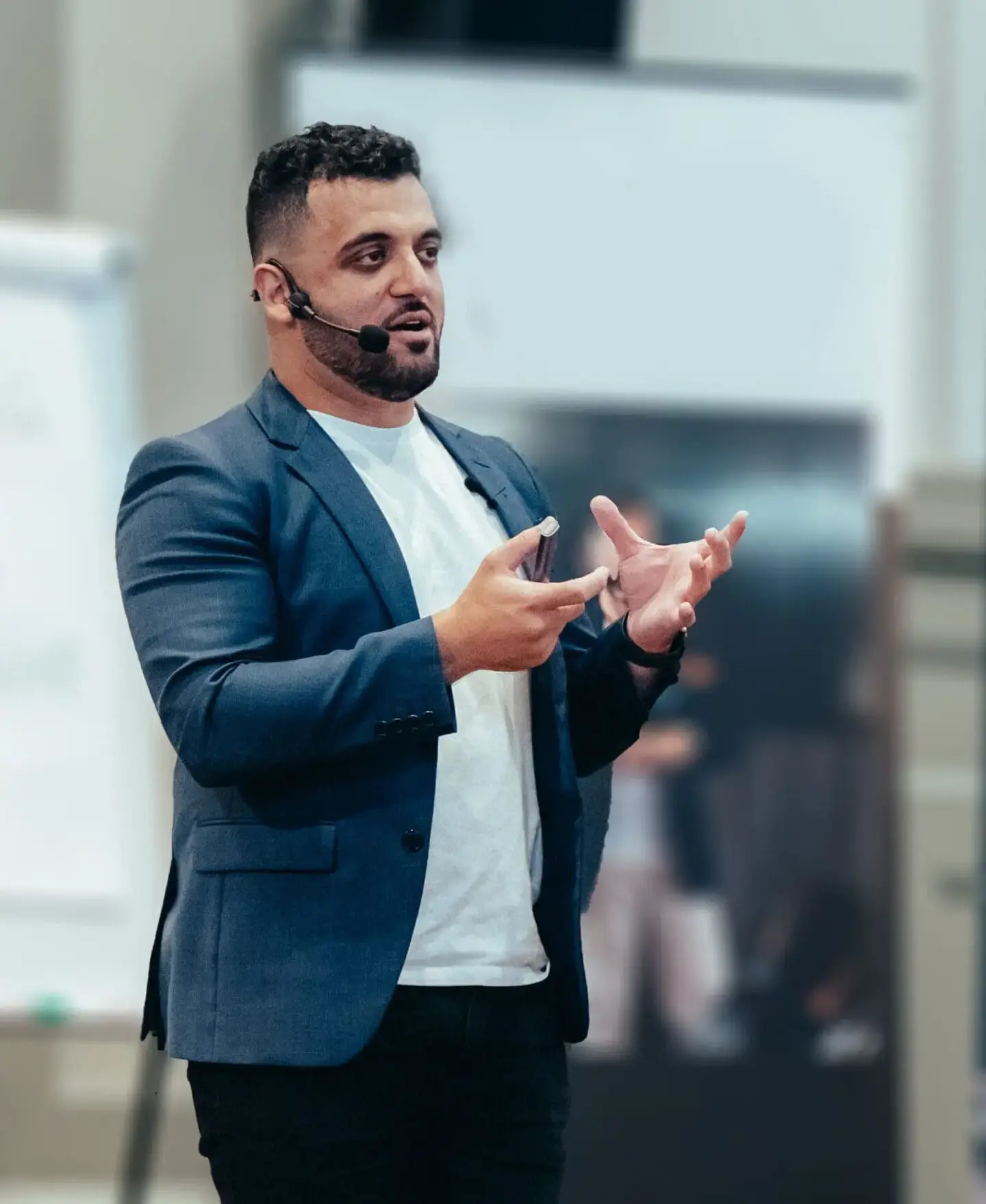Want smarter marketing? Join our FREE community — built for founders, marketers & creators.
What Is a Marketing Funnel? A Simple Guide for Business Owners

What Is a Marketing Funnel, Really?
If you’ve ever wondered why some businesses seem to turn clicks into customers on autopilot while others struggle to get a single enquiry, the answer is usually this:
They’re using a marketing funnel and they actually know what it looks like.
A marketing funnel is simply a map of the customer journey from the first moment someone discovers you, through to becoming a lead, a customer, and eventually a loyal repeat buyer. Instead of doing random marketing “stuff” a bit of Facebook here, some Google Ads there a funnel shows you:
- Who you’re trying to reach
- What to show them at each stage
- How to move them from “never heard of you” to “happy paying customer”
This guide is written for busy small business owners in Australia who want more leads, more sales, and better results from their digital marketing without drowning in jargon. You don’t need to be a marketing guru. You just need to understand the basics of the funnel and how to apply it to your business.
Why Marketing Funnels Matter for Small Businesses
Most small businesses don’t have a marketing problem. They have a marketing funnel problem. Typical stories we hear from Aussie business owners:
- “We’re getting decent traffic to the website, but hardly any inquiries.”
- “People ask for quotes and then disappear.”
- “We get one sale and never hear from them again.”
A clear marketing funnel helps you fix that by:
- Turning website visitors into leads (enquiries, bookings, phone calls)
- Turning leads into paying customers
- Turning customers into repeat buyers and referrers
In other words, it makes your online marketing strategy intentional instead of accidental.
With the right funnel structure, you can:
- Generate qualified leads for your small business
- Improve your return on ad spend (ROAS) from Google Ads and social ads
- Stop wasting money sending people to pages that don’t convert
- Understand which part of your marketing is working and which part is leaking money
If you care about lead generation for small businesses, a marketing funnel isn’t “nice to have”. It’s the backbone that holds your digital marketing together.
The Key Stages of a Marketing Funnel (Awareness to Loyalty)
Once you understand the basic stages of a funnel, everything else starts to make sense.
Most funnels follow this simple flow:
| Stage | What It Means |
| Awareness | They discover you. |
| Consideration | They research and compare options. |
| Conversion | They decide and take action. |
| Loyalty | They stay, spend more, and refer others. |
Let’s break that down in a way that’s actually useful.
Top of Funnel (TOFU): Awareness & Discovery
This is where people first discover your brand. They might:
- Search on Google for “plumber near me” or “dentist in Sydney”
- See one of your blog posts or guides
- Watch a short video on social media
- Hear about you from a friend or colleague
At this stage, they often don’t know you and may not even fully understand their problem yet.
Your goal at the top of the marketing funnel is to:
- Get their attention
- Show that you understand their problem
- Build a bit of trust, without pushing for the sale straight away
This is where content like blogs, SEO, social posts, short videos and helpful guides do a lot of heavy lifting.
Middle of Funnel (MOFU): Consideration & Evaluation
Now they know who you are. They’re starting to think:
“Okay, this business might be able to help me.”
At this stage, people:
- Compare you with competitors
- Read reviews and testimonials
- Check your pricing or packages
- Download a guide or join your email list
- Visit your website multiple times
Here, your job is to educate and reassure.
Middle-of-funnel content includes:
- Case studies
- FAQs and comparison guides
- Service pages that explain your process
- Lead magnets (checklists, templates, calculators)
- Email sequences that answer common questions
This is where you move from “just another option” to “clearly the best choice”.
Bottom of Funnel (BOFU): Conversion & Purchase
At the bottom of the funnel, they’re almost ready to buy.
They just need a clear, low-friction way to say “yes”.
Here’s what matters most:
- Strong, clear calls-to-action (CTA)
- Easy-to-use booking or enquiry forms
- Transparent pricing or next steps
- Social proof: reviews, case studies, guarantees
Bottom-of-funnel assets often include:
- Your main service pages
- Product pages (for e-commerce)
- Booking and quote forms
- Free consultation offers
- Retargeting ads to “warm” visitors
This is where conversion happens: an enquiry, a booking, a purchase, or a phone call.
After the Funnel: Retention & Loyalty
Most businesses stop at the sale.
The smart ones know this is where the real profit starts.
After someone buys, you want to:
- Stay in touch through email marketing or SMS
- Offer related services or upsells
- Ask for reviews and referrals
- Invite them into loyalty or maintenance programs
This customer retention and loyalty stage turns one-time customers into:
- Repeat buyers
- Long-term clients
- Brand advocates who refer their friends
That’s how you grow more profitably without constantly chasing new people at the top of the funnel.
Marketing Funnel vs Sales Funnel (What’s the Difference?)
You’ll often hear both terms thrown around: Marketing funnel, Sales funnel They’re related, but not the same.
| Marketing Funnel | Sales Funnel | |
| Main focus | Attracting and nurturing leads | Turning qualified leads into customers |
| What it covers | Awareness, education, and building trust | Quoting, proposals, follow-up calls, negotiations, closing |
| Typical activities | Content, ads, SEO, social media, email, etc. | Calls, meetings, proposals, negotiations, closing conversations |
| Who handles it | Marketing, digital agency, content/ads/SEO team | You, your sales team, or your appointment-setter |
You can think of it this way:
- The marketing funnel fills your pipeline
- The sales funnel converts that pipeline into revenue
For a small business in Australia, you don’t need a big complex setup.
You just need both sides to work together:
- Marketing brings in the right people
- Sales handles them properly and converts them
- The whole “funnel” feels smooth from the customer’s point of view
Types of Marketing Funnels (With Simple Examples)
There are dozens of funnel “models” out there, but most small businesses only need a few simple types. Here are three you’ll actually use.
Digital Marketing Funnel for Service Businesses
Perfect for: tradies, consultants, agencies, medical practices, local services.
A simple flow might look like this:
- Google search Someone searches “electrician in Brisbane”
- Service page or blog They land on a helpful, optimised page
- Trust builders Reviews, case studies, before/after photos
- CTA “Request a quote” or “Book online”
- Follow-up Email/SMS confirmation and reminder
This kind of digital marketing funnel is the bread and butter for local service businesses.
Lead Generation Funnel (Lead Magnet Funnel)
Perfect for: B2B services, agencies, accountants, coaches, consultants.
Here’s how it works:
- Visitor sees an offer like:
- “Free marketing checklist for local businesses”
- “Tax deductions cheat sheet for Australian tradies”
- They enter their email to download it
- They receive a helpful resource, not a hard sell
- Over the next few days/weeks, you send emails that:
- Answer common questions
- Share case studies
- Invite them to book a call or strategy session
This is a classic lead generation funnel that builds your email list and warms people up before you speak to them.
Email Marketing Funnel
Email is still one of the most powerful parts of a small business marketing funnel.
A simple email funnel could look like:
- Welcome email Thanks them for downloading / subscribing
- Value email Tips, guides, how-tos related to their problem
- Proof email Case study or testimonial
- Offer email Clear invite to book, buy, or request a quote
An email marketing funnel works quietly in the background, nurturing leads while you focus on running the business.
How to Create a Simple Marketing Funnel for Your Business
You don’t need fancy software or a massive budget. Start with something simple and build from there. Here’s a straightforward process:
Step 1: Define Your Ideal Customer and Main Offer
Ask yourself:
- Who do we really want to work with?
- What problem do we solve for them?
- What’s the main offer we want them to take? (e.g. free consult, quote, booking, package)
Without this, your funnel will feel messy and unfocused.
Step 2: Map Your Current Customer Journey
Before you build anything new, look at what’s already happening:
- How do people find you now? (Google, social, referrals, ads)
- What pages do they visit?
- Where do they drop off?
- Where do they enquire or buy?
Even a simple sketch on paper is enough to reveal obvious gaps.
Step 3: Plan Content for Each Stage of the Funnel
Think in terms of TOFU / MOFU / BOFU:
| Funnel Stage | Example Content Ideas |
| Top of Funnel (Awareness) | Blog posts and SEO content, social media posts, short videos or reels, basic “how to” or “what is” guides |
| Middle of Funnel (Consideration) | Case studies and success stories, detailed service pages, comparison guides (“us vs common alternatives”), lead magnets and email sequences |
| Bottom of Funnel (Conversion) | Clear service pages with strong CTAs, booking and enquiry forms, free consultation or quote offers, reviews, testimonials, guarantees |
This is your marketing funnel strategy in action.
Step 4: Choose Your Main Channels
You don’t need to be everywhere. Pick the channels that make sense for your business:
- SEO & Google Search Great for local intent (“near me” searches)
- Google Ads Fast way to appear for high-intent keywords
- Social media Good for awareness and retargeting
- Email marketing Essential for nurturing and retention
Focus on doing a few channels well, rather than doing everything badly.
Step 5: Set Up Basic Tracking
You can’t improve what you’re not measuring. At a minimum, set up:
- Google Analytics To see where your traffic comes from and what they do
- Google Search Console To see what people search for and how you show up
- Simple tracking for:
- Enquiry form submissions
- Online bookings
- Phone calls (if possible)
Even a basic customer journey map with a few key numbers will help you see where to optimise.
Marketing Funnel Examples
Let’s put this into a practical example.
Example: Duplex Builders Sydney
Goal: Increase new duplex design-and-build enquiries from Google.
Funnel could look like this:
- Awareness
- Someone searches “duplex builders Sydney”, “modern duplex builder in Sydney” or “duplex construction Sydney”
- They see your business in Google’s local results, map pack and organic search
- Consideration
- They click through to an SEO-optimised “Duplex Builders Sydney” service page
- They see:
- Clear overview of services
- Pricing ranges or payment options
- Genuine Google reviews
- Photos of the practice and team
- Conversion
- There’s a big, clear “Request a Duplex Quote” or “Book a Free Duplex Consultation” button
- The enquiry form is simple and mobile-friendly (block size, suburb, rough budget, time frame)
- They receive a confirmation email or SMS explaining next steps (e.g. site visit, feasibility, design briefing)
- Loyalty
- A week after their appointment, they get a follow-up email
- You invite them to:
- Leave a Google review mentioning their duplex build
- Refer friends or family considering a duplex in Sydney
- Join your mailing list for renovation/maintenance tips and future investment projects
This is a small business marketing funnel example that could also apply to:
- passive home builder
- steel fabrication
- traffic management melbourne
- Or a digital marketing agency like One Click Digital serving clients across Australia
Even a basic funnel like this can significantly increase leads, bookings, and revenue.
Tracking, Measuring, and Improving Your Funnel
Once your funnel is live, the real work begins: improvement.
Here are the key metrics to keep an eye on:
- Website traffic How many people are visiting? From where?
- Click-through rate (CTR) Are people clicking from search results or ads?
- Lead conversion rate What percentage of visitors become leads?
- Sales conversion rate What percentage of leads become customers?
- Cost per lead (CPL) / Cost per acquisition (CPA) What does each lead or sale cost you?
- Customer lifetime value (LTV) How much is a customer worth over time?
Then look for leaks in the funnel:
- Lots of traffic but few enquiries?
- Top or middle of the funnel problem (messaging, trust, value).
- Lots of enquiries but few sales?
- Bottom-of-funnel or sales process problem.
- Good first sales but no repeat business?
- Retention and loyalty problem.
Use tools like:
- Google Analytics
- Google Search Console
- Simple CRM or even a spreadsheet
The goal is not to be perfect, it’s to get a little better each month, based on data.
Common Marketing Funnel Mistakes (and How to Fix Them)
Here are some of the biggest mistakes we see small businesses make.
| Mistake | What It Looks Like | Fix |
| Mistake 1: Selling Too Early | Trying to close the sale at the first click. At the top of the funnel, people need value and clarity first. | Create more awareness and education content before pushing offers. |
| Mistake 2: Only Focusing on Traffic, Not Conversions | Getting more traffic but your website doesn’t convert visitors into enquiries or sales. | Improve your offers, CTAs, and key pages before you pour more money into ads. |
| Mistake 3: No Clear Next Step | People land on your site but don’t know what to do next. | Make your primary call-to-action obvious on every key page (call, book, request a quote). |
| Mistake 4: Ignoring Follow-Up and Retention | Treating every customer like a one-time transaction. | Use email and SMS to stay in touch, offer related services, and ask for referrals and reviews. |
Avoiding these marketing funnel mistakes alone can dramatically improve your results without increasing your ad spend.
FAQs to Popular “Marketing Funnel” Questions
What is a marketing funnel in digital marketing?
A marketing funnel in digital marketing is a simple model that shows how people move from discovering your business, to becoming a lead, to becoming a paying customer and beyond. It breaks the customer journey into stages so you can create the right message at the right time.
What are the 3 main stages of a marketing funnel?
The classic three stages are:
Awareness They discover you
Consideration They research and compare options
Conversion They decide and take action (enquire, book, buy)
Many businesses also add a fourth stage Loyalty/Retention to focus on keeping customers long-term.
What’s the difference between a marketing funnel and a sales funnel?
A marketing funnel focuses on attracting, educating, and nurturing potential customers using content, SEO, ads, social media, and email.
A sales funnel focuses on turning those warm leads into paying customers through calls, proposals, quotes, and follow-up.
You need both working together for best results.
Do small businesses really need a marketing funnel?
Yes, especially small businesses.
You may not call it a “funnel”, but you already have some sort of customer journey. Having a deliberate, optimised marketing funnel helps you get more leads and sales from the time and money you’re already spending on marketing.
How long does it take for a marketing funnel to work?
It depends on your industry, offer, and how much traffic you’re driving.
Some businesses see early wins in a few weeks
Meaningful, consistent results usually build over a few months
The key is to launch a simple version first, track your numbers, and improve over time instead of waiting for a “perfect” funnel.

Need Help Building Your Marketing Funnel?
You don’t need a complicated, high-tech setup to see real results.
You just need a clear, simple marketing funnel that matches how your ideal customers actually buy.
We work with businesses across Australia to:
- Map out their customer journey
- Build or fix their marketing funnel
- Optimise key pages for conversions
- Drive targeted traffic through SEO and paid ads
No jargon. No pressure. Just clear steps to help you turn clicks into customers.
